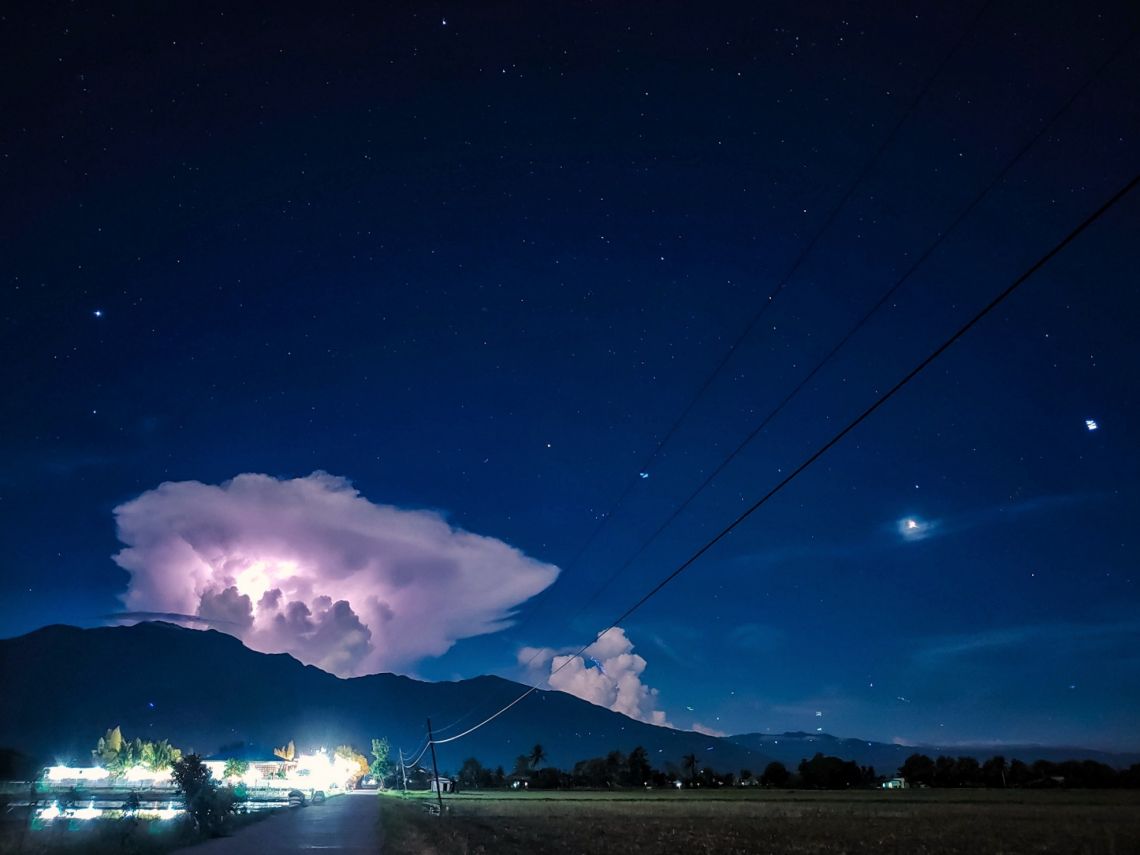On May 5, netizens on Facebook (FB) started sharing photos of a huge and illuminated cloud formation that appeared to have come from Mount Halcon’s peak in Oriental Mindoro, fueling speculation it was a volcanic eruption.
It was not. Mt. Halcon is not a volcano.
It became a much discussed topic online — as of May 8, social media monitoring tool CrowdTangle recorded 100 posts by private netizens, FB pages, and public groups carrying the words Mount or Mt. Halcon in them that were all related to the supposed eruption. These posts accumulated over 15,500 interactions from netizens.
Jaspher Ramirez, a photographer living in Calapan, Oriental Mindoro, uploaded one of the most shared captures of the scenery. He initially said he was puzzled by what he saw because even after taking 200 shots on his camera, the cloud was still there, unmoving above the mountain, amidst a clear sky. He said he could also see lightning striking the area.

A photo of the illuminated cloud above Mt. Halcon and one of the most shared captures of the cloud formation, taken by Jaspher Jake Ramirez on May 5.
The picturesque sight is merely a coincidence; due to the summer heat, a towering thunderstorm cloud formed, appearing to be located above the mountain.
Lorie Dela Cruz, a weather specialist from the Philippine Atmospheric, Geophysical and Astronomical Services Administration (PAGASA), told VERA Files in a phone interview:
“Iyong cumulonimbus clouds, pwede iyon ma-form especially sa hapon, lalo na kung mainit. Hindi ba sa Mindoro, natatala rin iyong mga pinakamatataas na temperatures ngayon. So likely very prone sa thunderstorm formation iyong lugar na iyon (Cumulonimbus clouds can be formed especially in the afternoon, more so if it is hot. Mindoro has recently been recording the highest temperatures. So it is likely that the place is very prone to thunderstorm formation).
Cumulonimbus clouds are low clouds formed during the developing stage of a thunderstorm. They are “dark, heavy, and dense,” and usually look like “huge towers” with a flat top “shaped like an anvil.”
PAGASA released a weather forecast some hours before photos of the cloud formation made rounds online, alerting people of “isolated rain showers” caused by “localized thunderstorms” in Oriental Mindoro.
Netizens from areas near the mountain claim there was continuous lightning, but that the sky was clear and that it was not raining. However, there have been reports of heavy rainfall in Paluan, Occidental Mindoro — two towns from Baco, where Mt. Halcon is.
Dela Cruz said this “could also be true,” as thunderstorms come in a “very small scale.” For example, a cloud formation due to a thunderstorm in one city, which may not reach and affect its neighboring cities despite the short distance, can still be seen from nearby places.
The formation of thunderstorms is highly affected by high temperatures, as they are usually “driven by heating” during summer days. In the past week, the average highest temperature recorded in both Oriental and Occidental Mindoro was 35 degrees Celsius, according to historical weather database Wolfram Alpha.
San Jose, a municipality in Occidental Mindoro, recorded on April 20 the highest heat index of 2020 in the country, with 58 degrees Celsius.
Sources
Philippine Institute of Volcanology and Seismology, “Reports of an alleged eruption at Mt. Halcon…,” May 5, 2020
Jaspher Jake Ramirez, “Hindi ko sure kung kidlat lang…,” May 5, 2020
Dela Cruz, Lorie, Personal correspondence, May 6, 2020
Dela Cruz, Lorie, Personal correspondence, May 7, 2020
Philippine Atmospheric, Geophysical and Astronomical Services Administration, Clouds, n.d.
National Severe Storms Laboratory, Thunderstorm Basics, Feb. 11, 2019
Philippine Atmospheric, Geophysical and Astronomical Services Administration, Southern Luzon Regional Weather Forecast, May 5, 2020
Philippine Atmospheric, Geophysical and Astronomical Services Administration, Southern Luzon Regional Weather Forecast, May 5, 2020
National Severe Storms Laboratory, Thunderstorm Types, Feb. 11, 2019
Wolfram Alpha, Baco, Oriental Mindoro temperature, May 8, 2020
Wolfram Alpha, Oriental Mindoro temperature, May 8, 2020
Philippine Atmospheric, Geophysical and Astronomical Services Administration, Maximum Heat Index, May 8, 2020
(Guided by the code of principles of the International Fact-Checking Network at Poynter, VERA Files tracks the false claims, flip-flops, misleading statements of public officials and figures, and debunks them with factual evidence. Find out more about this initiative and our methodology.)
